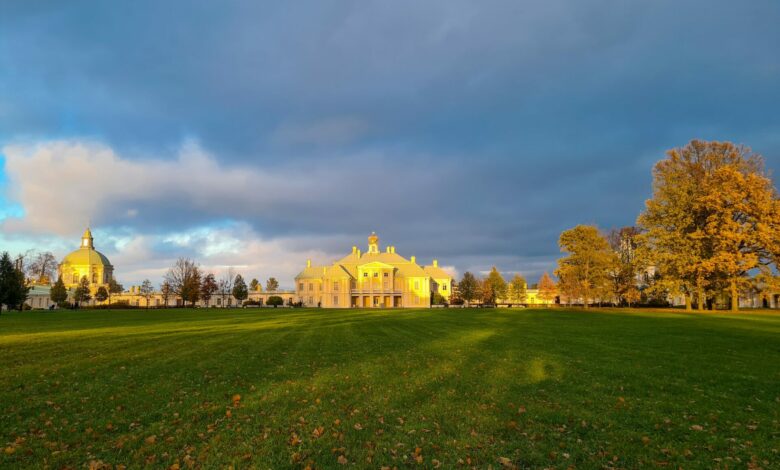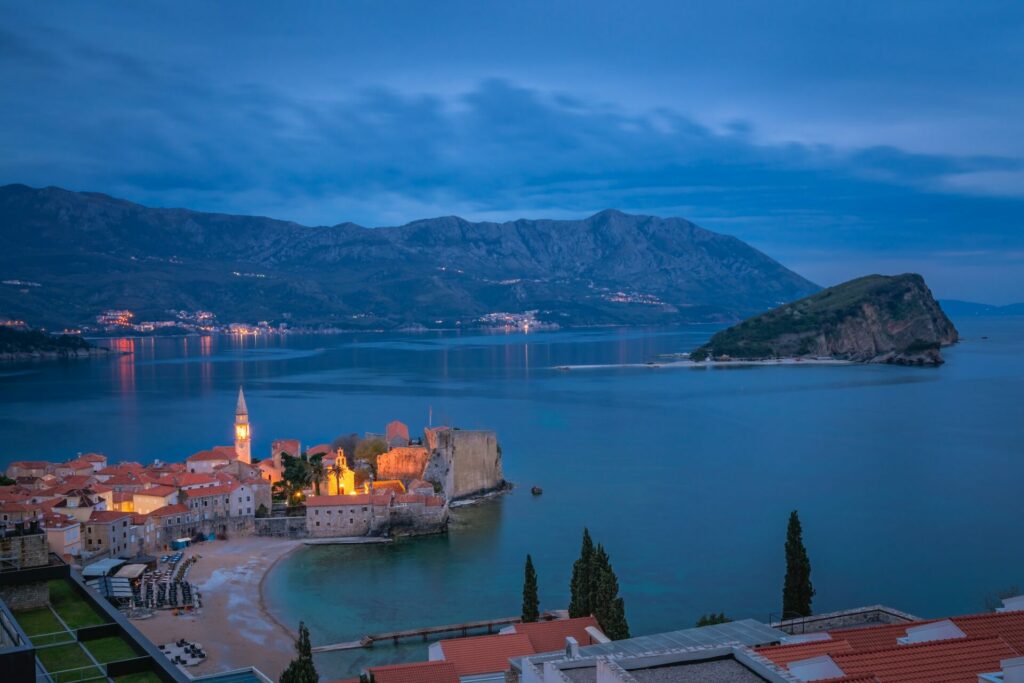
India, with its rich tapestry of history and cultural heritage, is home to numerous majestic palaces and royal residences that have witnessed centuries of regal grandeur. These architectural wonders, which were formerly the homes of kings and queens, have been painstakingly renovated and turned into heritage hotels, providing guests with a rare chance to enter the luxurious world of the past. In this article, we explore the intriguing process through which India’s royal heritage homes have been saved and transformed into hotels, giving these majestic buildings a new lease on life while respecting their historical relevance. In addition to offering opulent lodging, these heritage hotels guard the imperial legacy of India and let guests experience the luxury, grace, and beauty of a bygone period. These heritage hotels provide a distinctive fusion of history, luxury, and cultural immersion, from the renowned Lake Palace in Udaipur, which appears to float on the placid waters of Lake Pichola, to the grandeur of Rambagh Palace in Jaipur, which was originally the palace of the Maharaja of Jaipur. They provide visitors a look into the illustrious past and magnificent architecture of India’s royal dynasties. These palaces and royal houses have undergone painstaking renovation, becoming havens of luxury and hospitality while meticulously conserving their original architectural details, exquisite artwork, and opulent interiors.
Join us as we explore the captivating world of India’s royal heritage homes transformed into hotels, where history comes alive, and guests are transported back in time to relish the grandeur and magnificence of India’s regal past.
Taj Falaknuma Palace, Hyderabad

Taj Falaknuma Palace, perched 2,000 feet above Hyderabad’s busy city, is a spectacular example of the splendour and majesty of the Nizams, Hyderabad’s former kings. The Taj Group manages this spectacular palace, which provides visitors a royal experience unlike any other. The late 19th century saw the construction of Taj Falaknuma Palace, often known as the “Mirror of the Sky,” by Nawab Vikar-ul-Umra, the ruler of the princely state of Hyderabad. Later, the Nizam of Hyderabad bought it and turned it into his regal abode. The palace’s design is a gorgeous blend of Tudor and Italian styles, embellished with elaborate stucco work, chandeliers from Venice, and magnificent murals. Every nook of the Taj Falaknuma Palace emanates a feeling of grandeur and elegance, from the impressive Durbar Hall to the breathtaking Jade Room. Traditional Hyderabadi hospitality is used to welcome visitors, and they are given royal treatment the entire time they are there. The castle provides a variety of opulent suites, each richly adorned with antique furniture, handcrafted objects, and period pieces. At the renowned restaurants within the castle, indulge in regal dining experiences. The grand dining hall, adorned with gilded ceilings and crystal chandeliers, serves delectable Hyderabadi cuisine, featuring iconic dishes like biryani, haleem, and kebabs. Taj Falaknuma Palace stands as a custodian of Hyderabad’s rich history and cultural heritage. A stay at Taj Falaknuma Palace is a journey into the regal splendor of Hyderabad’s past.
The Bawali Rajbari, West Bengal
The majestic Bawali Rajbari is located in the lovely countryside of West Bengal, India. This architectural masterpiece, which served as the ancestral residence of the Bawali Zamindars (landlords), has been painstakingly renovated and turned into a heritage hotel, providing visitors with a window into Bengal’s illustrious past. Bawali Rajbari is a real example of the preservation of India’s royal legacy with its rich history, gorgeous architecture, and opulent lodgings. The Mondal family, who were the Zamindars of Bawali, built Bawali Rajbari in the late 18th century, which is when it first appeared. The family lived in this opulent estate for many years, displaying their riches, authority, and influence in the neighbourhood. However, over time, the grandeur of Bawali Rajbari started to fade, and the once magnificent estate fell into a state of neglect and disrepair. The mansion stood as a silent witness to the changing times and the decline of the Zamindari system. It wasn’t until recent years that the current owners, the Ghosh family, took up the herculean task of restoring this architectural masterpiece and breathing new life into it. The Ghosh family started a thorough restoration effort, making sure to maintain every detail of the mansion while also adding contemporary conveniences to provide visitors a pleasant stay. The Bawali Rajbari’s architectural characteristics are a tasteful fusion of Indian and European styles, demonstrating the influence of the British Raj. A variety of opulent lodging options are available at Bawali Rajbari, each with their own special charm and personality. The elegantly constructed heritage rooms and suites incorporate classic features with contemporary amenities. The Rajbari also has contemporary conveniences including swimming pools, spas, exercise centres, and a variety of eating alternatives. Visitors have the option of indulging in mouthwatering Bengali food made with locally sourced ingredients and time-honored recipes or enjoying foreign cuisine in a fine dining environment. The Rajbari collaborates with adjacent farmers, artisans, and craftspeople to build a sustainable ecology that benefits the local community’s economy and cultural legacy.
Umaid Bhawan Palace, Jodhpur
Umaid Bhawan Palace, which rises majestously above Chittar Hill in Jodhpur, Rajasthan, is a symbol of the splendour and wealth of Rajasthan’s royal past. The Taj Group now operates this famous palace as a luxury historic hotel, providing visitors with a genuinely regal experience amid stunning architecture, lush grounds, and unrivalled hospitality. Maharaja Umaid Singh ordered the construction of Umaid Bhawan Palace in the 1920s, and it took 15 years to complete. The palace, which was created by British architect Henry Lanchester, features a beautiful fusion of Indo-Saracenic and Art Deco styles. The palace is a remarkable architectural marvel with its golden-yellow sandstone exterior, vast courtyards, and elaborate domes. Umaid Bhawan Palace is one of the largest private mansions in the world, spanning over 26 acres. It boasts 347 rooms, including luxurious suites and opulent chambers, each adorned with period furniture, antique artifacts, and exquisite artwork. The palace’s grand Durbar Hall, with its 105-foot-high ceiling and intricately carved walls, leaves visitors in awe of its grandeur. Staying at Umaid Bhawan Palace is an indulgence in luxury and regal living. The palace offers world-class amenities and services, ensuring that guests experience the finest in hospitality. Umaid Bhawan Palace offers guests a plethora of royal experiences that transport them back to the era of the maharajas.
Bari kothi, West Bengal
Bari Kothi is a wonderful monument to the majesty and legacy of Bengal and is located in the centre of Azimganj, a historical town in the Murshidabad district of West Bengal, India. This architectural masterpiece, which was formerly the home of affluent merchants, has undergone thorough restoration to become a boutique heritage hotel. Bari Kothi offers visitors an immersive experience that mixes luxury, history, and the kind hospitality of Bengal, showcasing the region’s rich cultural heritage. The Dudhoria family, renowned merchants and zamindars (landlords) of the area, had their ancestral mansion, Bari Kothi, built in the 18th century. Bari Kothi has seen the rise and fall of empires, the impact of colonial European powers, and the shifting sociopolitical environment of the nation over time. But as time went on, the mansion started to deteriorate and ran the risk of being forgotten, losing its previous splendour. The present owners, the Singhi family, invested their passion and time into restoring Bari Kothi. Their goal was to restore the mansion’s historical and cultural relevance while also establishing a magnificent refuge where visitors could fully experience the local culture. The core of Bari Kothi’s philosophy is the preservation of the local cultural heritage. The mansion houses a museum that showcases a collection of artifacts, photographs, and documents that narrate the history of Murshidabad and its significant role in Bengal’s past. Cultural performances, storytelling sessions, and guided heritage walks are organized to provide guests with a deeper understanding of the local traditions, art, and architecture. Bari Kothi tantalizes guests’ taste buds with its delectable Bengali cuisine. Guests can savor traditional delicacies like shorshe ilish (hilsa fish in mustard sauce), kosha mangsho (slow-cooked mutton curry), and mishti doi (sweet yogurt).
Rambagh Palace, Jaipur
Nestled in the bustling city of Jaipur, Rajasthan, the Rambagh Palace is a magnificent testament to the grandeur and royal heritage of the Pink City. Once the residence of the Maharaja of Jaipur, this opulent palace has been transformed into a luxury heritage hotel managed by the Taj Group. The origins of Rambagh Palace date back to the 18th century. Originally, it was a modest royal garden house. Over the years, it underwent several extensions and renovations under different rulers, culminating in its transformation into a magnificent palace. The architectural style reflects a harmonious blend of Rajput and Mughal influences, adorned with stunning domes, intricate marble work and beautifully landscaped gardens. Upon entering Rambagh Palace, visitors are transported into a world of royal splendor. At Rambagh Palace, guests enjoy an exceptional level of luxury and personalized service. The palace staff, renowned for their warm Rajput hospitality, ensure that every guest feels like a member of the royal family. From the warm welcome at traditional Rajasthani ceremonies to the fulfillment of every need, attention to detail and impeccable service set Rambagh Palace apart. Rambagh Palace is the guardian of Rajasthan’s rich heritage.
Lake Palace, Udaipur
Travellers have been enthralled by Udaipur’s Lake Palace for ages as it delicately rises from the placid waters of Lake Pichola. This famous palace, which is now a five-star hotel run by the Taj Group, is a living example of Rajasthan’s opulent architecture and regal appeal. Lake Palace provides visitors with an amazing experience in a tranquil haven of luxury thanks to its breathtaking location, beautiful craftsmanship, and unrivalled hospitality. For Maharana Jagat Singh II of Udaipur, Lake Palace, also known as Jag Niwas, was constructed in the 18th century as a vacation residence. Its white marble facade creates the illusion that it is floating on the clear waters of Lake Pichola, making it one of the most romantic hotels in the world. The palace is a well-known landmark in Udaipur due to its distinctive setting and exquisite architecture. The palace offers opulent lodging options, such as elegantly furnished apartments and rooms with spectacular views of the lake or the nearby Aravalli Hills. The interiors combine traditional Rajasthani design with contemporary conveniences to provide visitors a relaxing and luxurious stay. Visitors are given unparalleled comfort and first-rate service at Lake Palace. From a warm welcome with traditional music and rose petals to individualised butler service attending to every need, the crew makes sure that every part of the guest experience is perfect. A stay at Lake Palace is a magical experience that whisks visitors away to a land of peace, splendour, and regal charm. Visitors are surrounded by a calming and romantic ambiance as the sun sets over Lake Pichola and casts a golden glow on the marble exterior of the palace.
Itachuna Rajbari
Itachuna Rajbari is a spectacular heritage mansion that is tucked away in the idyllic countryside of West Bengal, India’s Hooghly district. Itachuna Rajbari provides tourists with a chance to revisit the illustrious age of Bengal’s zamindars (landlords) through its rich history, architectural splendour, and cultural relevance. The Kundu family, famous zamindars of the area, constructed Itachuna Rajbari, also known as Bargee Danga, in the 18th century. The Kundu family actively participated in the independence movement against British control during the colonial era. The mansion developed into a hub for political gatherings, intellectual conversations, and cultural events, drawing notable figures of the day. Itachuna Rajbari witnessed the ups and downs of history and is a testament to the spirit and tenacity of the Bengali people. The Neotia family, Itachuna Rajbari’s present owners, completed a painstaking restoration operation recently to preserve and restore the mansion’s splendour. Visitors are welcomed into a realm of regal splendour by the magnificent façade of the mansion, which is embellished with delicate carvings and beautiful balconies. Itachuna Rajbari offers more than just opulent lodging. Visitors can also savour authentic Bengali cuisine while indulging in culinary pleasures. Exploring the surrounding area reveals a treasure trove of historical landmarks, including the ruins of the old fort of Itachuna and the iconic Hooghly Imambara.
Neemrana Fort Palace, Neemrana
Neemrana Fort Palace, perched spectacularly on a hill in the Aravalli Range, is a stunning example of India’s rich historical and architectural legacy. The 15th-century fort in the Rajasthani village of Neemrana has been painstakingly repaired and turned into a distinctive heritage hotel. The fort played a significant role in regional politics and witnessed the rise and fall of several dynasties. Today, it stands as a living testament to the architectural brilliance and grandeur of Rajasthan’s historical forts. A fascinating fusion of Rajput and Mughal architectural styles may be found in Neemrana Fort Palace, a unique architectural wonder. Visitors are in awe of its multi-tiered building, which is adorned with elaborate carvings, complex jharokhas (balconies), and vast courtyards. The fort palace offers breathtaking 360-degree views of the Neemrana village and the nearby Aravalli hills. Guests can choose to stay in rooms that were once the chambers of kings and queens, each exuding a distinct charm and character. The fort palace provides an array of amenities to ensure a comfortable and memorable stay.
Taj Nadesar Palace, Varanasi
The Taj Nadesar Palace is a serene haven that expertly combines regal splendour with the spiritual heart of Varanasi. It is tucked away among lush gardens. Visitors can feel the allure of monarchy while immersing themselves in Varanasi’s rich cultural legacy at this heritage palace, which is now a luxury hotel run by the Taj Group. The Taj Nadesar Palace has a history that goes back over two centuries. It was first built by the Maratha Peshwas before becoming the residence of the Maharajas of Varanasi. The palace’s architecture is a skilful blend of Mughal and Maratha styles, with ornate domes, arched doorways and sculpted facades. The palace is surrounded by lush gardens and extensive orchards, providing a serene and picturesque setting. The warm and personalized hospitality at Taj Nadesar Palace ensures that every guest is treated like royalty. Varanasi, known as the spiritual capital of India, holds immense cultural and religious significance. With the help of organised tours, visitors can travel on a spiritual journey to the Ganges River’s holy ghats. Take a boat trip along the river while taking in the ancient customs and rituals that are being performed there, including the mesmerising Ganga Aarti (the practise of praying to the river). Beyond the palace, visitors can stroll through the winding streets of Varanasi’s historic district, go to ancient temples, and interact with locals to learn more about the city’s rich tradition and history. The concierge at the palace may help plan cultural outings including musical and dance performances, cooking lessons, and excursions to old-world silk looms.
Laxmi Niwas Palace, Bikaner
Laxmi Niwas Palace is the pinnacle of richness and regal allure, located in the centre of the magical city of Bikaner, Rajasthan. The majestic palace, which is now a luxurious heritage hotel, displays the Indo-Saracenic architectural genius and provides visitors with an unparalleled experience immersed in the majesty and splendour of Rajasthan’s regal history. The Laxmi Niwas Palace was built in the early 20th century by Maharaja Ganga Singh of Bikaner. Designed by British architect Sir Samuel Swinton Jacob, the palace reflects a fusion of Indian, European and Mughal architectural styles. Its imposing red sandstone façade, intricate carvings and majestic domes create a visual spectacle that captures the imagination. The palace’s grand public spaces, including the ornate Durbar Hall and the lavish dining rooms, transport guests back to an era of refined elegance and lavish banquets. Traditional Rajasthani folk dance and music performances, captivating puppet acts, and camel rides into the desert are all available to visitors. The palace also offers guided tours to explore the historic attractions of Bikaner, including the Junagarh Fort and the stunning Bhandasar Jain Temple. Laxmi Niwas Palace is dedicated to preserving the rich heritage of Bikaner and Rajasthan. Furthermore, the palace promotes sustainable practices and actively contributes to the local community by supporting various social initiatives, including education and healthcare programs. It is a place where history, culture, and luxury converge, providing an enchanting escape for those seeking an extraordinary experience in the heart of the Thar Desert.
Narendra Bhawan, Bikaner
Narendra Bhawan is a tribute to the charismatic and visionary Maharaja Narendra Singhji, who was known for his progressive mindset and love for art, culture, and cuisine. The hotel’s design and concept take inspiration from the various phases of his life, creating a captivating narrative that unfolds as guests explore the property. Narendra Bhawan stands as a testament to the seamless integration of traditional Rajputana architecture and modern aesthetics. The property boasts a striking exterior with its white façade and grand arches, while the interiors exude a sense of understated luxury with clean lines, contemporary furnishings, and curated artwork. Narendra Bhawan offers thoughtfully designed and beautifully appointed accommodations that showcase a blend of classic elegance and modern comfort. The rooms and suites are individually styled, each reflecting a different facet of the Maharaja’s life and interests. From the Art Deco-inspired rooms to the eclectic suites that pay homage to the Maharaja’s travels, every space is a testament to the hotel’s meticulous attention to detail. Guests can indulge in bespoke experiences that reflect the Maharaja’s passions. Narendra Bhawan offers immersive cultural encounters that allow guests to delve into the rich heritage and vibrant traditions of Bikaner.
Ahilya Fort, Maheshwar
As the home of Queen Ahilyabai Holkar, one of the most admired monarchs of the Holkar dynasty, Ahilya Fort is of enormous historical value. The fort was built in the 18th century and was used by the queen as her refuge. With beautifully carved facades, elegant balconies, and exquisite frescoes showing the finest craftsmanship of the time, its architectural style blends Maratha, Rajput, and Mughal influences. The fort allows visitors to explore the architectural splendour and cultural treasures contained within its walls, providing a genuinely immersive heritage experience. Every area of Ahilya Fort, from its opulent courtyards and tranquil gardens to its stunning temples and cenotaphs, narrates a tale of its glorious past. Visitors can join guided tours to discover the fort’s history, observe customary rituals, and awe at the exquisite craftsmanship that graces the fort’s interiors. Maheshwar is well known for its rich cultural and spiritual traditions. A portal to the spiritual and cultural wonders of the city is provided by Ahilya Fort. Visitors are welcome to take part in the evening aarti (prayer ceremony) at the famed Maheshwar Temple, which is close to the fort. The fort’s scenic setting on the banks of the Narmada River, its extensive historical past, and its gracious hospitality combine to create a calming and alluring atmosphere.
Sujan Rajmahal Palace, Jaipur
Rajmahal Palace has a lengthy, illustrious past. This architectural wonder, which was initially constructed as a private palace for the Maharaja of Jaipur, has witnessed the splendour of royal celebrations and hosted eminent visitors from all over the world. The seamless blending of Rajput and British colonial elements in the palace’s design has produced a mesmerising aesthetic that oozes everlasting grandeur. The Sujan Rajmahal Palace provides a variety of opulent suites that perfectly combine traditional charm and contemporary comfort. The palace’s extensive grounds are a tranquil refuge that offer a peaceful haven in the midst of the busy metropolis. Sujan Rajmahal Palace is renowned for its exceptional service and personalized attention to every guest’s needs. The dedicated staff ensures that every aspect of the stay is tailored to perfection, from warm and gracious welcomes to arranging curated experiences and excursions.
Samode Palace, Jaipur
The Samode royal dynasty has resided in Samode Palace since its founding by Rajput kings in the sixteenth century. The palace’s architecture, which is highlighted by elaborate paintings, complex mirror work, and fine marble carvings, is a harmonic fusion of Rajput and Mughal traditions. The palace’s every crevice and feature transports visitors to a previous period of wealth and sophistication. The palace offers a variety of magnificent lodgings, such as roomy suites, lavish royal apartments, and attractive courtyard rooms. The cuisine of Samode Palace is known for showcasing the variety of flavours found in Rajasthan. The team goes above and beyond to make every visitor’s stay exceptional, from a unique welcoming ceremony to scheduling excursions and cultural acts.
Udaivilas, Udaipur
Udaivilas is a haven of luxury and regal splendour located in the enchanted city of Udaipur along the shores of Lake Pichola. The Oberoi Group’s spectacular royal hotel provides visitors a magical experience that immerses them in Rajasthan’s imperial allure and rich cultural history. Udaivilas showcases the architectural splendor of Rajasthan’s palaces and havelis. The palace hotel is designed in the style of a traditional Rajasthani palace, with intricate domes, majestic arches, and sprawling courtyards. Its location on the shores of Lake Pichola provides breathtaking views of the lake, the Aravalli hills, and the city’s iconic landmarks. Udaivilas offers lavish accommodations that exude regal elegance and provide a haven of comfort for guests. Rich textiles, handcrafted furnishings, and elaborate artwork adorn the rooms and suites, fusing classic design with contemporary conveniences. Many of the suites have private pools and breath-taking views of the lake or the lush gardens surrounding the palace. The Oberoi Group, renowned for its immaculate service, is famed for its famous hospitality, which is offered to visitors at Udaivilas. From personalised check-ins to attentive service during the stay, the staff makes sure that every part of the visitor experience is handled to with the highest care. Whether dining al fresco with views of the lake or taking in a romantic candlelit dinner in the palace’s exquisite interiors, guests can savour the finest meals cooked by talented chefs. For those seeking relaxation and rejuvenation, Udaivilas offers a luxurious spa that combines ancient Ayurvedic therapies with modern wellness practices. Guests can also partake in yoga and meditation sessions in the palace’s serene surroundings, embracing the tranquility and spirituality of Udaipur.
In conclusion, India’s heritage hotels provide a window into the nation’s extensive cultural past. Visitors can travel back in time and experience the splendour and splendour of the royal age by visiting these palaces and royal mansions, which have been painstakingly restored. Each heritage hotel offers a distinctive fusion of history, elegance, and hospitality, from the opulent palaces of Rajasthan to the serene forts in isolated areas. Visiting these hotels is a once-in-a-lifetime opportunity that leaves visitors with enduring recollections of India’s regal past.


